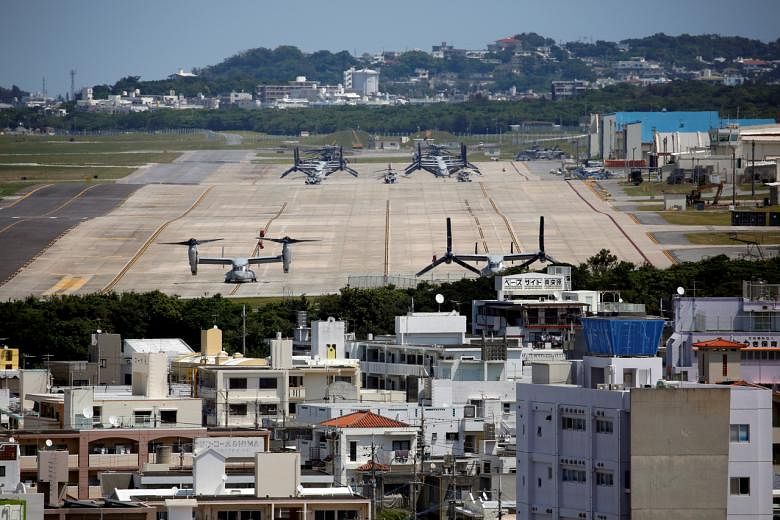JAKARTA (THE JAKARTA POST/ASIA NEWS NETWORK) - The recently announced deal of eight MV-22 Osprey tilt-rotor aircraft to Indonesia, the first in Southeast Asia, signifies an attempt to improve its airlift capability with certain challenges ahead.
The Indonesian archipelago of more than 17,500 islands represents a significant demand for military airlift, especially for time-sensitive missions, such as disaster relief, search and rescue.
Regarding the demand for airlift, the Indonesian armed forces have established certain capacities, and its indigenous aerial industry has become an important supplier for rotary and fixed-wing transport aircraft. However, there is a gap between fixed-winged and rotary airlift in terms of speed.
The fixed-winged aircraft is faster than its rotary counterpart but airfields or at least a certain size of flat ground is indispensable.
Although most models of transporter aircraft in the Indonesian service, from C-130 to NC-212, are capable of short take-off and landing (STOL) to accept airfields with poor conditions, there are still many areas unsuitable for them, except airdrop with parachutes.
This constraint is crucial for the largest archipelagic country, as it is impossible to make airstrips available on every island, despite the governmental effort in infrastructure. In contrast, helicopters with the vertical take-off and landing (VTOL) capability are convenient to reach most places among the archipelago, but they are relatively slow, and the speed matters in the time-sensitive missions, particularly in Indonesia's broad territory.
The distribution of helicopters nationwide helps to enhance their coverage over the large Indonesian territory, but there are still some corners in assigned areas where take time for helicopters to reach.
Before the deal of Osprey, Jakarta narrows the gap by acquiring several types of light fixed-wing aircraft for lower demand on runways, such as CN-235, NC-212, and N-219, to broaden their accessible locations, and introduction of the helicopter models with a relatively large payload and long-range, such as Super Puma Family from SA-330 to the latest H-225, for the areas without airstrips.
The main challenge to this arrangement is the speed because the cruise speed of H-215 is about 135 knot (250 km/hr), much slower 237 kt (438 km/hr) of CN-235.
In contrast, the MV-22 stands for an alternative better than the current options for its cruise speed of 500 km, faster than CN-235 and other light fixed-wing aircraft, and the radius of 428 nm (792km), longer than CN-235 of 414nm and H-215 of 350 nm.
Furthermore, the deal including several types of equipment, such as forward-looking infrared radars, missile warning and countermeasure dispenser, indicates the capability of the Osprey penetrating a hostile area for search and rescue or sending special forces. In other words, this deal would be a milestone for Indonesia to advance airlift capability for operations in both peacetime and wartime.
Aside from the promising outlook, the Indonesian MV-22s could face several challenges, namely external logistical, aerial refueling capacity, training and maintenance.
Jakarta's unpleasant memory of the military sanction posed by Washington between 1992 and 2005 suggests the risk of logistical dependence.
If the United States really pursues its Indo-Pacific strategy, the unique geostrategic location of Indonesia may weight on the bilateral relations and thus preserve the logistical supply of the MV-22s.
Moreover, the MV-22s would build up greater interoperability between the Indonesian and US militaries, for advancing their current bilateral exercises and other joint operations.
In order to fully exert the speed of the MV-22s, it would be necessary to improve Indonesia's existing aerial refuelling capacity of extending their ranges to match with the wide-spread archipelago.
The Indonesian Air Force has acknowledged the geographic condition and possessed KC-130B aerial refuelling aircraft for decades, but the number has been reduced to one, according to Military Balance published by the International Institute for Strategic Studies (IISS).
As such, to introduce additional aerial refuelling aircraft, whether C-130 or other platforms, would be a factor of determining the value of the MV-22s, and the upcoming C-130J deal could be an opportunity.
Finally, training and maintenance would be the very test for the Indonesian Military to handle the Osprey. The Indonesian armed forces have suffered a relatively high frequency of crashes and other accidents, both fixed-wing and rotary aircraft, which could be attributed to either training or maintenance in recent years.
The sophisticated tilt-rotor mechanism of MV-22s would pose unprecedentedly technical challenges to both crews and ground staff, as the losses by the US operators reveals certain demand on training and maintenance.
Within the limited scale of the procurement, each asset occupies one-eighth of the capability, and it suggests a considerable impact from any damage or loss.
Eclipsed by larger projects, such as F-16V fighters, the MV-22 deal may not stand out, but it symbolises an attempt of the Indonesian armed forces to explore a new capability to supplement the existing ones.
It is also a sign of the stable bilateral relations between Indonesia and the United States.
According to the high costs of procurement and maintenance, the Indonesian Osprey fleet is unlikely to rapidly expand, and the mainstay of its military airlift will remain on the current fixed-wing and rotary assets.
However, as long as the Indonesian operator overcome the difficulties and master the MV-22s, they could be seen an additional military icon, just like their F-16C/D fighters and AH-64E Apache attack helicopter, with frequent exposure in exercises and other operations.
The writer is a research fellow in the Regional Security Architecture Program at the S Rajaratnam School of International Studies (RSIS), Nanyang Technological University (NTU), Singapore. The Jakarta Post is a member of The Straits Times media partner Asia News Network, an alliance of 24 news media organisations.

